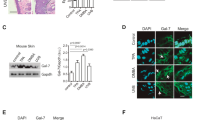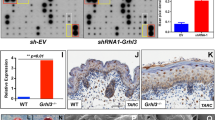Abstract
Human skin tumours often regress spontaneously due to immune rejection. Murine skin tumours model this behaviour; some regress and others progress in syngeneic immunocompetent hosts. Previous studies have shown that progressor but not regressor skin tumours inhibit dendritic cell (DC) migration from the tumour to draining lymph nodes, and transforming growth factor-β1 (TGF-β1) has been identified as a responsible factor. To determine whether increased production of TGF-β1 in the absence of other differences inhibits DC migration from the tumour and enables it to evade immune destruction, a murine regressor squamous cell carcinoma clone was transfected with the gene for TGF-β1. This enhanced growth in vitro and in vivo, causing it to become a progressor. TGF-β1 transfection reduced the number of infiltrating DCs by about 25%. Quantitation of CD11c+ E-cadherin+ (epidermally derived) DCs in lymph nodes determined that TGF-β1 reduced the number of DCs that migrated from the tumour to undetectable levels. This was supported by showing that TGF-β1 reduced DC migration from cultured tumour explants by greater than tenfold. TGF-β1 transfection also reduced the number of infiltrating CD4 and CD8 T cells. Thus, TGF-β1 production by skin tumours is sufficient to immobilise DCs within the tumour, preventing their migration to lymph nodes. This reduces the number of T cells that infiltrate the tumour, preventing regression. Thus, TGF-β1 is a key regulator of whether skin tumours regress or progress.







Similar content being viewed by others
Abbreviations
- DC:
-
Dendritic cell
- LC:
-
Langerhans cell
- TGF (A) and (B):
-
Transforming growth factor-β1 transfected clones
- TGF-β1:
-
Transforming growth factor-β1
- UVR:
-
Ultraviolet radiation
- UCo:
-
Untransfected clone
- VCo:
-
Empty vector transfected clone
References
Halliday GM, Barnetson RSC (1999) Spontaneous regression. In: Chu AC, Edelson RL (eds) Malignant tumors of the skin. Arnold, London, pp 411–424
Cavanagh LL, Halliday GM (1996) Dendritic epidermal T cells in ultraviolet-irradiated skin enhance skin tumor growth by inhibiting CD4(+) T-cell-mediated immunity. Cancer Res 56:2607–2615
Byrne SN, Halliday GM (2003) High levels of fas ligand and MHC class II in the absence of CD80 or CD86 expression and a decreased CD4(+) T cell infiltration, enables murine skin tumours to progress. Cancer Immunol Immunother 52:396–402
Lucas AD, Halliday GM (1999) Progressor but not regressor skin tumours inhibit Langerhans’ cell migration from epidermis to local lymph nodes. Immunology 97:130–137
Halliday GM, Le S (2001) Transforming growth factor-beta produced by progressor tumors inhibits, while IL-10 produced by regressor tumors enhances, Langerhans cell migration from skin. Int Immunol 13:1147–1154
Iwamoto M, Shinohara H, Miyamoto A, Okuzawa M, Mabuchi H, Nohara T, Gon G, Toyoda M, Tanigawa N (2003) Prognostic value of tumor-infiltrating dendritic cells expressing CD83 in human breast carcinomas. Int J Cancer 104:92–97
Byrne SN, Halliday GM (2002) Dendritic cells: making progress with tumour regression? Immunol Cell Biol 80:520–530
Nestle FO, Alijagic S, Gilliet M, Sun YS, Grabbe S, Dummer R, Burg G, Schadendorf D (1998) Vaccination of Melanoma patients with peptide- or tumor lysate-pulsed dendritic cells. Nat Med 4:328–332
Hersey P, Menzies SW, Halliday GM, Nguyen T, Farrelly ML, DeSilva C, Lett M (2004) Phase I/II study of treatment with dendritic cell vaccines in patients with disseminated melanoma. Cancer Immunol Immunother 53:125–134
Byrne SN, Halliday GM (2003) Phagocytosis by dendritic cells rather than MHC II high macrophages is associated with skin tumour regression. Int J Cancer 106:736–744
Gabrilovich DI, Ciernik IF, Carbone DP (1996) Dendritic cells in antitumor immune responses 1 defective antigen presentation in tumor-bearing hosts. Cell Immunol 170:101–110
Chaux P, Favre N, Martin M, Martin F (1997) Tumor-infiltrating dendritic cells are defective in their antigen-presenting function and inducible B7 expression in rats. Int J Cancer 72:619–624
Borkowski TA, Letterio JJ, Farr AG, Udey MC (1996) A role for endogenous transforming growth factor beta 1 in Langerhans cell biology: the skin of transforming growth factor beta 1 null mice is devoid of epidermal Langerhans cells. J Exp Med 184:2417–2422
Caux C, Massacrier C, Dubois B, Valladeau J, Dezutter-Dambuyant C, Durand I, Schmitt D, Saeland S (1999) Respective involvement of TGF-beta and IL-4 in the development of Langerhans cells and non-Langerhans dendritic cells from CD34(+) progenitors. J Leukoc Biol 66:781–791
Gruschwitz M, Muller PU, Sepp N, Hofer E, Fontana A, Wick G (1990) Transcription and expression of transforming growth factor type beta in the skin of progressive systemic sclerosis: a mediator of fibrisis? J Invest Dermatol 94:197–203
Beck C, Schreiber H, Rowley DA (2001) Role of TGF-beta in immune-evasion of cancer (Review). Microsc Res Tech 52:387–395
Josien R, Douillard P, Guillot C, Muschen M, Anegon I, Chetritt J, Menoret S, Vignes C, Soulillou JP, Cuturi MC (1998) A critical role for transforming growth factor-beta in donor transfusion-induced allograft tolerance. J Clin Invest 102:1920–1926
Fairlie WD, Russell PK, Wu WM, Moore AG, Zhang HP, Brown PK, Bauskin AR, Breit SN (2001) Epitope mapping of the transforming growth factor-beta superfamily protein, macrophage inhibitory cytokine-1 (MIC-1): identification of at least five distinct epitope specificities. Biochemistry 40:65–73
Patel A, Halliday GM, Cooke BE, Barnetson RS (1994) Evidence that regression in keratoacanthoma is immunologically mediated: a comparison with squamous cell carcinoma. Br J Dermatol 131:789–798
Larsen C, Steinman R, Witmer-Pack M, Hankins D, Morris P, Austyn J (1990) Migration and maturation of Langerhans cells in skin transplants and explants. J Exp Med 172:1483–1493
Byrne SN, Halliday GM, Johnston LJ, King NJC (2001) Interleukin −1β but not tumor necrosis factor is involved in West Nile virus-induced Langerhans cell migration from the skin in C57BL/6 mice. J Invest Dermatol 117:702–709
Dahler AL, Cavanagh LL, Saunders NA (2001) Suppression of keratinocyte growth and differentiation by transforming growth factor beta 1 involves multiple signaling pathways. J Invest Dermatol 116:266–274
Dissanayake NS, Mason RS (1998) Modulation of skin cell functions by transforming growth factor-beta-1 and acth after ultraviolet irradiation. J Endocrinol 159:153–163
Nugent MA, Lane EA, Keski-Oja J, Moses HL, Newman MJ (1989) Growth stimulation, altered regulation of epidermal growth factor receptors, and autocrine transformation of spontaneously transformed normal rat kidney cells by transforming growth factor beta. Cancer Res 49:3884–3890
Reiss M (1997) Transforming growth factor-beta and cancer—a love–hate relationship. Oncol Res 9:447–457
Ebert EC (1999) Inhibitory effects of transforming growth factor-beta (TGF-beta) on certain functions of intraepithelial lymphocytes. Clin Exp Immunol 115:415–420
Torre-Amione G, Beauchamp RD, Koeppen H, Park BH, Schreiber H, Moses HL, Rowley DA (1990) A highly immunogenic tumor transfected with a murine transforming growth factor type beta 1 cDNA escapes immune surveillance. Proc Natl Acad Sci USA 87:1486–1490
Tang A, Amagai M, Granger LG, Stanley JR, Udey MC (1993) Adhesion of epidermal Langerhans cells to keratinocytes mediated by E-cadherin. Nature 361:82–85
Schwarzenberger K, Udey MC (1996) Contact allergens and epidermal proinflammatory cytokines modulate Langerhans cell E-cadherin expression in situ. J Invest Dermatol 106:553–558
Borkowski TA, Vandyke BJ, Schwarzenberger K, Mcfarland VW, Farr AG, Udey MC (1994) Expression of E-cadherin by murine dendritic cells: E-cadherin as a dendritic cell differentiation antigen characteristic of epidermal Langerhans cells and related cells. Eur J Immunol 24:2767–2774
Johnston LJ, Halliday GM, King NJC (1996) Phenotypic changes in Langerhans Cells after infection with arboviruses—a role in the immune response to epidermally acquired viral infection. J Virol 70:4761–4766
Cui W, Fowlis DJ, Bryson S, Duffie E, Ireland H, Balmain A, Akhurst RJ (1996) TGFbeta1 inhibits the formation of benign skin tumors, but enhances progression to invasive spindle carcinomas in transgenic mice. Cell 86:531–542
Acknowledgments
This work was supported by the National Health and Medical Research Council of Australia, the Melanoma and Skin Cancer Research Institute, University of Sydney, the Fondation René Touraine and the University of Innsbruck, Austria. The Centre for Immunology and the Melanoma and Skin Cancer Research Institute are supported by New South Wales Health Research and Development Infrastructure grants.
Author information
Authors and Affiliations
Corresponding author
Rights and permissions
About this article
Cite this article
Weber, F., Byrne, S.N., Le, S. et al. Transforming growth factor-β1 immobilises dendritic cells within skin tumours and facilitates tumour escape from the immune system. Cancer Immunol Immunother 54, 898–906 (2005). https://doi.org/10.1007/s00262-004-0652-3
Received:
Accepted:
Published:
Issue Date:
DOI: https://doi.org/10.1007/s00262-004-0652-3




